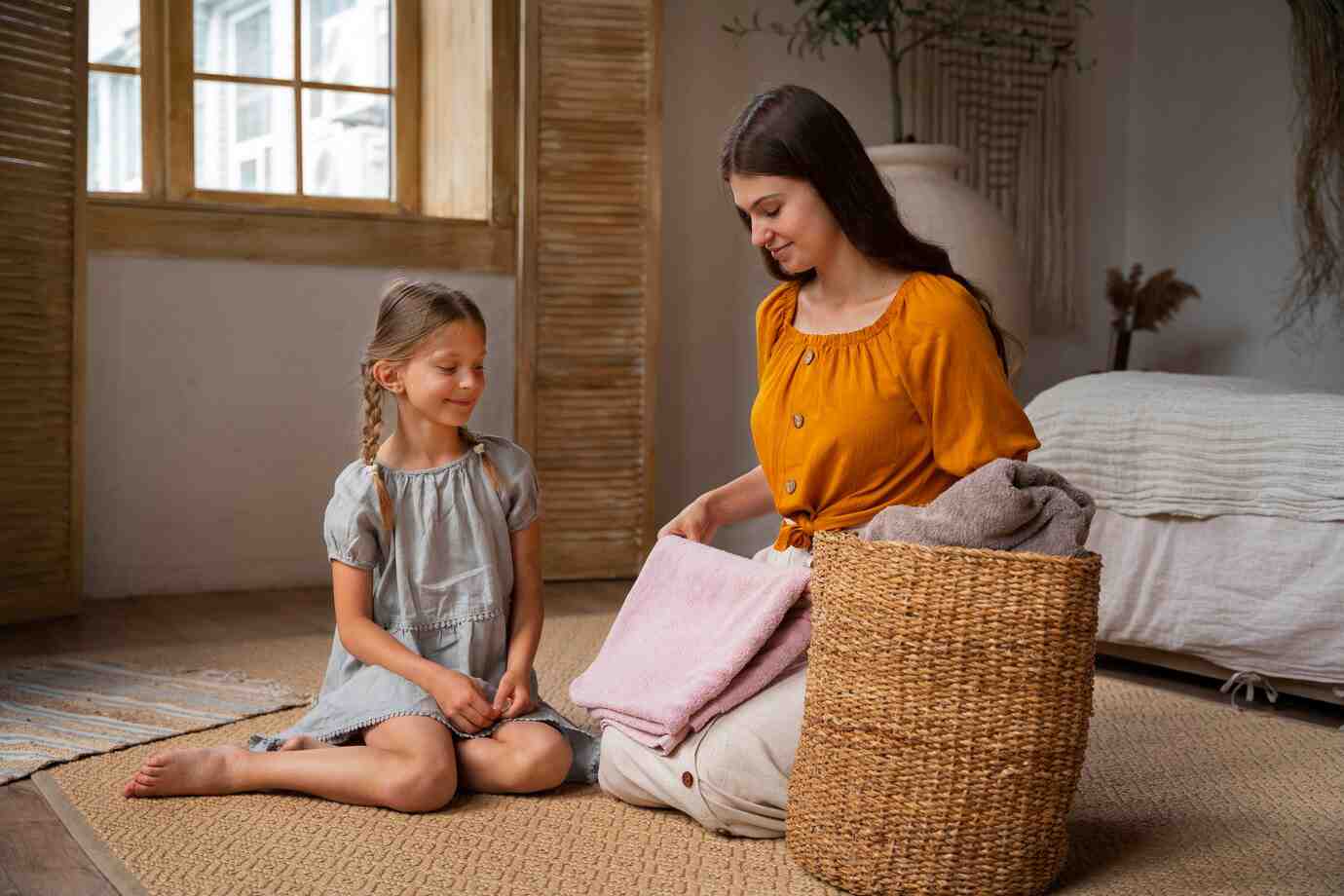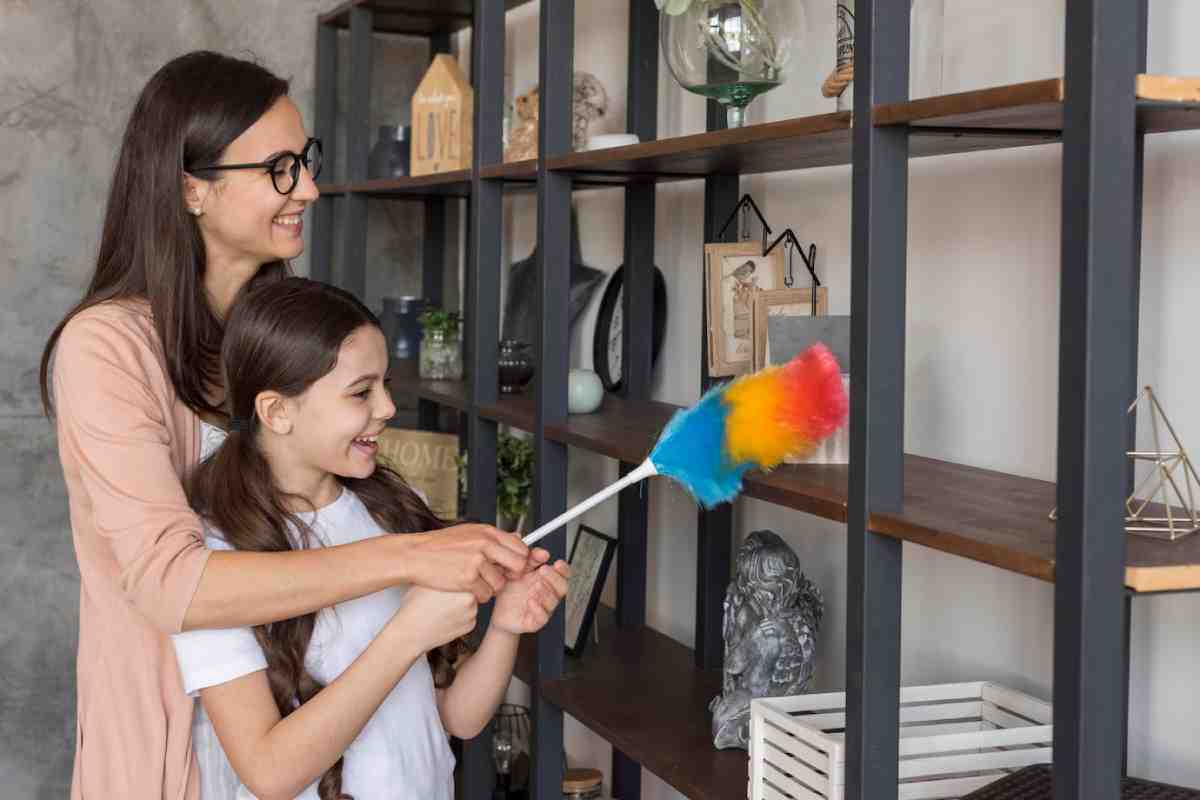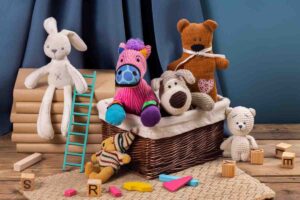The Interior Blog

Teaching Kids the KonMari Method: A Parent’s Guide
Imagine a world where your child cheerfully tidies up their toys without a fuss. Sounds dreamy, doesn’t it? In a world overflowing with stuff, kids’ decluttering is more essential than ever. But how do we guide young ones to appreciate organisation without turning it into a dreaded chore?
Enter the KonMari Method, created by the internationally acclaimed tidying expert, Marie Kondo. This simple yet profound method isn’t just about folding shirts perfectly — it’s about cultivating joy and mindfulness. Teaching organising through KonMari principles can transform your home and instil lifelong habits in your children.
In this guide, we’ll explore practical ways to teach kids the art of tidying up, share relatable experiences, and offer actionable tips to make family organisation a joyful journey. Ready to spark joy in your family spaces? Let’s dive in.
Why Teach Kids the KonMari Method?

Building Lifelong Skills
Teaching kids to organise early lays the groundwork for:
- Responsibility: Kids learn to take ownership of their belongings.
- Mindfulness: Understanding what brings joy helps develop emotional intelligence.
- Independence: An organised space empowers kids to manage tasks themselves.
Reducing Stress and Clutter
A chaotic environment can overwhelm children. Studies show that clutter negatively impacts focus and creativity. Helping your child maintain a tidy space fosters a calming atmosphere that enhances well-being.
Understanding the KonMari Philosophy for Kids
Before introducing KonMari to your little ones, it’s essential to grasp its core:
- Joy-Driven Decisions: Keep only what “sparks joy.”
- Respect for Belongings: Treat items with gratitude.
- Tidying by Category, Not Location: Sort clothes, books, toys, etc., separately.
Adapt the philosophy with age-appropriate language and activities — it doesn’t have to be textbook perfect.
Tailoring the Message
Explain it like this: “We’re going to keep the things that make you the happiest and find new homes for things you’ve outgrown or don’t love anymore.”
How to Introduce KonMari to Your Kids
Start with a Family Meeting

Hold a casual meeting to discuss why you’re embarking on a decluttering journey. Emphasise:
- It’s about making their room more fun and happy.
- They get to be in charge of what stays.
- It’s not a punishment, but a family adventure!
Lead by Example
Children mirror adult behaviour. Start by applying KonMari principles to your own belongings. Narrate your decisions: “This book makes me so happy because it reminds me of adventures.”
Teaching the KonMari Method to Kids
Create a Joyful Atmosphere
- Play upbeat music.
- Make it a game: “Who can find the happiest toy first?”
- Offer small incentives: stickers, a special treat, or an extra bedtime story.
Tidy by Category, Not by Room
Begin with the least emotional categories. A suggested order:
- Clothing: Easy wins, as kids quickly outgrow clothes.
- Books: Help them sort through stories.
- Toys: The big one!
- Miscellaneous items: Trinkets, art supplies, etc.
Hold Each Item
Encourage your child to physically hold each item and ask, *”Does this make me happy?”
If they seem unsure, use relatable prompts: “Do you still like playing with this dinosaur?”
Thank and Release
Teach them to thank items they’re letting go of: “Thank you for the fun times.”
This small ritual fosters gratitude and softens the emotional blow of parting with once-loved items.
Designate a Special “Joy Space”
Reserve a shelf, drawer, or box for their most treasured items. This builds excitement and a sense of pride.
Overcoming Common Challenges
“My child wants to keep everything!”
- Strategy: Set limits: “Choose your five favourite stuffed animals to keep on your bed.”
- Reframe: Instead of focusing on what’s going away, celebrate what’s staying.
“They get overwhelmed and give up.”
- Strategy: Break sessions into 15-30 minute chunks.
- Support: Offer choices: *”Would you like to sort books or toys today?”
“They miss items they gave away.”
- Strategy: Validate feelings: “It’s okay to miss your toys. It means they were special.”
- Solution: Take photos of items before letting go to create a memory album.
Making KonMari a Habit for the Whole Family
Regular “Joy Checks”
Schedule seasonal decluttering days. Make it an event: decorate with balloons or create a “spark joy” playlist.
Celebrate Progress
Acknowledge every effort with words of praise: *”You made great choices today! Your room feels so happy!”
Model Ongoing Tidying
Continue applying the KonMari philosophy to adult spaces. Kids notice more than we realise.
Real-Life Stories: KonMari Wins with Kids
One parent, Emma from Kent, shared how her six-year-old daughter, Lily, transformed after learning KonMari. Initially overwhelmed by a mountain of toys, Lily now proudly maintains her “special shelf” — a curated selection of toys that truly make her smile.
Another success story comes from Mark, a dad of two boys, who said: “Since we started family tidying days, arguments have lessened. Everyone feels more in control and less stressed.”
These real-world examples show that even the smallest tidying victories can ripple positively across the family dynamic.
Key Tips for KonMari Success with Kids
- Stay Positive: Enthusiasm is contagious!
- Be Patient: Progress may be slow at first.
- Allow Mistakes: If a child regrets letting go of an item, use it as a learning moment.
- Involve Them Fully: Respect their decisions whenever possible.
- Have Fun: Turn decluttering into a joyful family memory, not a chore.
Conclusion: Creating Lifelong Joy Through Family Tidying

Teaching kids the KonMari Method isn’t about creating picture-perfect rooms — it’s about nurturing gratitude, mindfulness, and confidence. By gently guiding your children to choose what truly sparks joy, you empower them with skills that extend far beyond their bedrooms.
Remember: Family space organisation isn’t a one-off task; it’s an evolving journey filled with small victories, laughter, and a little bit of chaos. And that’s perfectly okay.
Ready to embrace the joy of kids decluttering? Share your tidying adventures in the comments, tag us in your “before and after” photos, and inspire other families to spark joy together!









